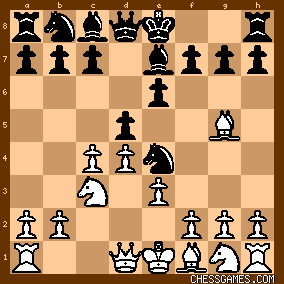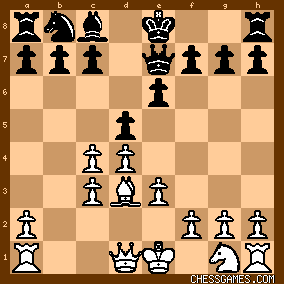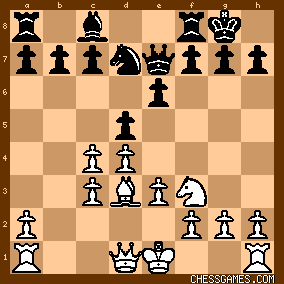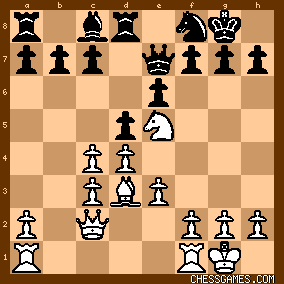|
< Earlier Kibitzing · PAGE 2 OF 4 ·
Later Kibitzing> |
| Jul-17-08 | | Lutwidge: Lasker understood so well how to create difficulties for his opponents that even the most tactically gifted players (Marshall, Janowski) tended to blunder horribly against him. However, the more pragmatic players, (such as Pillsbury, Schlecter, Rubinstein and, obviously, Capablanca) fared rather better. |
|
| Jul-17-08 | | micartouse: There's also a difference between trying to force tactics and just calculating according to the position. A lot of Marshall games give the impression that he took great risks to mix it up, and that it worked against most players. Lasker, Capablanca, and Alekhine were all better tacticians who didn't try so hard - they just let it happen normally. They certainly didn't fear complications against Marshall either. |
|
Jul-17-08
 | | keypusher: <Lutwidge> <Lasker understood so well how to create difficulties for his opponents that even the most tactically gifted players (Marshall, Janowski) tended to blunder horribly against him. > That they did, but his plus scores against both were huge -- blunders only explain a small part of it. E.g., look at Lasker's two wins over Marshall at St. Petersburg 1914. Marshall doesn't blunder, he just gets outplayed tactically. <However, the more pragmatic players, (such as Pillsbury, Schlecter, Rubinstein and, obviously, Capablanca) fared rather better.> That's an interesting point. Might quarrel with you about Pillsbury being pragmatic, but he certainly had a better score against Lasker than most! It's hard to draw conclusions about Lasker and Rubinstein, since they played each other so little. |
|
Jul-17-08
 | | chancho: Marshall won the first game in 1900 and could not win another game from Emanuel until 1940, when he was 72 years old: search "marshall vs lasker" 4 decades of frustration for Mr. Marshall. |
|
| Jul-18-08 | | Lutwidge: <keypusher> <That they did, but his plus scores against both were huge -- blunders only explain a small part of it. E.g., look at Lasker's two wins over Marshall at St. Petersburg 1914. Marshall doesn't blunder, he just gets outplayed tactically.> Sure, most of the time Marshall and Janowski would just drift (or charge) into dodgy positions vs Lasker, but it's remarkable to me how often they would botch the few decent chances they managed to create (or stumble upon). Anyhow, I suppose Marshall and Janowski probably weren't quite as good at chess as a whole as Rubinstein or Capablanca, but it's interesting to compare, say, Rubinstein's very close match with Marshall (I forget the final score) or Pillsbury's/Schlechter's close tournament records vs Tarrasch/Janowski/Marshall to Lasker's one-sided match scores against the same trio. Of course, tournaments aren't matches, but I suspect that a Lasker - Rubinstein (Or Lasker - Pillsbury) match would have been much closer to the drawn Schlechter match than the Tarrasch/Marshall/Janowski routs. Alas, when all's said and done, there's really not nearly enough games between Lasker and his main rivals around that time to draw any profound conclusions, except that Lasker didn't play enough tournaments during his WC tenure. Oh well. :) |
|
Mar-04-09
 | | Honza Cervenka: 33...Nxc3 seems to give black sound extra Pawn with good winning chances, for example 34.Kh1 (34.Rxc3 Qxd4+ 35.Kh1 Qxc3) 34...Nxb1 35.Qxd5+ Qf7 36.Qxf7+ Kxf7 37.Rxb1 Ke6 38.Rc1 Rf7 39.g3 Kd5 and Pd4 falls. |
|
| Mar-04-09 | | Absentee: <notyetagm:
I am with you, <Calli>. Marshall was one of the all-time greatest tacticians. Reuben Fine said that Marshall was THE strongest tactical player that he knew of, including Alekhine and Spielmann!>With all due respect for Fine, players like Rubinstein, Schlechter or Alekhine himself were far better at tactics than Marshall. |
|
| Mar-04-09 | | Jim Bartle: If Marshall was in fact the greatest tactician of his era, as Fine claimed, he must have been a really horrible positional player. Otherwise how could his record against the quartet of Alekhine, Rubinstein, Capablanca and Lasker be 15 wins and 51 losses? |
|
Mar-04-09
 | | sleepyirv: Hmm... So basically Lasker didn't fall into Monday's puzzle. Not too shocking, I suppose. |
|
Mar-04-09
 | | keypusher: <Jim Bartle: If Marshall was in fact the greatest tactician of his era, as Fine claimed, he must have been a really horrible positional player.
Otherwise how could his record against the quartet of Alekhine, Rubinstein, Capablanca and Lasker be 15 wins and 51 losses?> Well, exactly. And if you look at his games you quickly see that he was a quite good positional player. Here is an example of which he was rightly proud: Teichmann vs Marshall, 1911
Since he was positionally strong, I think the necessary inference is that he wasn't quite as good at tactics as the best players of his own time. Fine, who said such nice things about Marshall's tactics, also supposedly said that Lasker was the "supreme tactical genius." Capablanca's speed and sureness in calculating was legendary. And Alekhine -- well, think of all his great combinations. |
|
Mar-04-09
 | | keypusher: Hmm, since Teichmann apparently missed a late draw (damn you, analytically proficient cg.com posters!) better add these. Alapin vs Marshall, 1912
Marshall vs Spielmann, 1906
The point is, you can come up with quite a few nice positional wins for Marshall. I just strolled through his best games collection for these. |
|
| Mar-04-09 | | Calli: Game Collection: My Favorite Marshalls |
|
Dec-30-09
 | | GrahamClayton: <notyetagm>What game of the match was this? It must have been an odd-numbered game because Marshall had White in those games. <notyetagm>,
This is Game 3, if the order of the index to the games of the match is correct. |
|
| Jan-10-10 | | Adriano Saldanha: With all due respect, the annotation on white´s move 29 looks somewhat dubious. In fact it was Lasker who took the pawn on 28 ...cxd4, perfectly conscious that cxd4 couldn´t be done as white looses a rook. So white could ONLY capture with the e-pawn. No trap for me, sorry if im wrong. |
|
| Jan-26-11 | | Oceanlake: I think Nimzovich studied this opening. |
|
| Jan-26-11 | | TheFocus: <Oceanlake> Why do you think that? I don't believe Nimzowitsch ever played this variation. |
|
| Jan-26-11 | | Oceanlake: The pawn formation; doubled c pawns. |
|
May-08-13
 | | oao2102: Why not 25...cxd4 26. exd4 f6 and 27...Rxc3 ? |
|
| Nov-07-13 | | Ulhumbrus: It may be that the move 13 Rab1 develops the rook to the wrong file, although this file seems half opened for White. Black is able to obstruct the rook by ...b6, and the rook does little on the file. If we assume that the way for White to make use of his central pawn superiority is to play the pawn advances f3 and e4 this suggests that he may need this rook on d1. This suggests 13 Rad1 |
|
| Nov-24-13 | | backrank: Chernev ('The golden Dozen') gives Black's 33rd move as Qe3+ (instead of Qg5 as given here). The chesslab.com database has also Qe3+, while db.mychess.com has Qg5.
Certainly Qe3+ is more forcing, while Qg5 simply defends the d5-pawn, threatening Rf2, but letting White escape by 34 Rf1. I can't believe Emanuel would have played Qg5. But where do the different scores come from, and can we find out which one is correct? For such a beautiful and distinguished game, the answer is very important, I think. |
|
| Nov-24-13 | | backrank: Now I have looked up the game in 'Kings of Chess' by William Winter, and he gives 33 ... Qe3+, too. It seems to become more and more likely that the cg.com score is incorrect and Qe3+ is the move that has been actually played. |
|
Aug-06-15
 | | Volcach: Even at move 41 Marshall had a chance to trade his Queen for the Rook with Qh5. Computer thinks the position is dead drawn |
|
Apr-12-16
 | | Sally Simpson: Yeah here.

click for larger viewAs mentioned above Black did not play 33.Qg5 it was 33.Qe6+ correction slip sent - they are probably fed up with me sending in corrections. |
|
Jul-30-19
 | | KEG: Having lost the first two games of this World Championship match to Lasker, Marshall switched from 1. e4 as White to 1. d4. Starting with this game, Marshall played 1. d4 as White for the rest of the match. This hardly turned the match around for him, giving that in the remaining games in which Marshall had White (including this game) he won 0 games, lost three, and drew four. To the extent Marshall had planned to rely on the Queen's Gambit Declined, he ran into a version of what became known as Lasker's defense (i.e., ...Ne4 by Black) and later Tarrash'c Defense (...c5). Lasker won two of the three games in which he played Lasker's Defense and drew the other (both games with Tarrasch's Defense were drawn). Lasker also defeated Marshall's QGD in one game (Game 13) with Tchigorin's Defense. The major problem, of course, was not the opening. The major problem was that Lasker was a vastly superior player. Given this, Marshall needed to find a way to obtain an advantage with White. This he failed to do here and throughout the match. 1. d4 d5
2. c4 e6
3. Nc3 Nf5
4. Bg5 Be7
5. e3 Ne4

click for larger viewThis was Lasker's surprise in this match. The contemporary reaction was mixed: "This is known as Lasker's Defense, which he played in response to requests for some defense to the Queen's Gambit that would give Black winning chances." (Schroeder). "A favorite move of Mr. Atkins, who played it both in this country (i.e., England), and at the Hanover Tournament, but there is hardly any more use for it, whatever its merits might be, as 4...Nbd7 is almost invariably played now." (Hoffer). "This move has been tried,but never with much success." (Tchigorin) "M. Janowski also disapproves of this move as the Knight cannot remain long in its position." (Wilson) Capablanca was apparently impressed by 5...Ne4 and played in seven times in his 1909 match against Marshall (winning three, losing one, and drawing three). The best overall and historical assessment of 5...Ne4, however, comes from Soltis in his excellent book on Lasker: "This became the 'Lasker Defense' after he used it three times in this match. It became a favorite of Capablanca's and, in revised form (5...h6 6. Bh4 0-0 7. Nf3 Ne4), of modern GMs such as Artur Yusupov. But it wasn't well received in 1907. 'This move has been tried before but never with much success.' Teichmann wrote of 5...Ne4. Tarrasch called it a mistake because Black will be forced to exchange on c3, strengthening White's center. When Leonhardt played 5...Ne4 (after 5. Nf3 0-0 6. c3) against him at Ostend 1905, he declared it the 'decisive error.' " The current game, as will be seen, was not won or lost because of 5...Ne4. 6. BxB QxB
7. Bd3
This was played again by Marshall in Game 5 of this match. In Game 15, he switched to (the better--but not best) 7. cxd5. Against Capablanca, Marshall played 7. Bd3 three times, 7. cxd5 three times, and 7. Qb3 in one game. Contemporary commentators argued that 7. cxd5 was best: "White's best continuation is 7. cxd5." (Teichmann) "The Bishop move is not in order. The correct continuation, whch was played by Alapin v. Leonhardt in Ostend 1905, is 7. cxd5." (Tarrasch). While 7. cxd5 was indeed superior to the text, better still are 7. Rc1 or 7. Nge2. In fairness to Marshall, however, the text is hardly a blunder, and White is certainly not worse after 7. Bd3. It had the merit here of persuading Lasker to trade off his advanced Knight and thereby strengthening the White center. 7... NxN
8. bxN

click for larger viewBoth sides were probably reasonably happy with the above position. Marshall had survived Lasker's surprise, and Lasker had obtained a fully playable position was Black. |
|
Jul-31-19
 | | KEG: Post II
8... Nd7
Probably best here for Black is 8...dxc4 as played by Capablanca in Game 11 of his 1909 match with Marshall (Capablanca, however, played 8...Nd7 in Games 5 and 7 of the 1909 match). 8...0-0 was also good. Tarrascah, however, had other ideas:
"Black should immediately take advantage of the weak 7. Bd5 with 8...c5. The move c5 for Black in the Queen's Gambit, when it can be played at all, leads to equality." 9. Nf3
"Better is 9. cxd5 exd5 10. Qb3 [even better here is 10. Nf3--KEG] followed by c4. Marshall certainly does not recognize what advantage his opponent his bestowed upon him by strengthening his center through the exchange of Knights." (Tarrasch). Tarrasch arguably (and characteristically) overstates his case, but 9. cxd5 does look best. 9. Qb3 immediately also gives White a small edge. 9... 0-0
While the text was certainly sound, 9...dxc4 was probably best. In Game 5 of this match, Lasker played 9...e5 here, which also leads to decent chances for Black. Capablanca played the text in Games 5 and 7 of his match with Marshall. After 9...0-0, the position was:

click for larger view10. 0-0
White has several reasonable options here.
"10. Qc2 first seems better, as Black would then have been forced to weaken the Pawns before the King or play Nf6, which move allows White to establish his Knight on e5." (Wilson). Following the above reasoning, Marshall played 10. Qc2 in Game 5 of his 1909 match with Capablanca (in a game Capablanca eventually won). In Game 7 of that same match, Marshall played 10. cxd5 against Capablanca (and scored his one and only win in the match). The text is also reasonable, but yields virtually no advantage to White. 10... Rd8
As Hoffer pointed out, Lasker was making room for Nf8. But 10...dxc4 or 10...e5 were much better. 11. Qc2
Yet again declining to play the (better) 11. cxd5. 11. Qb3 was also a good choice. 11... Nf8
As planned on his prior move. But--yet again--dxc4 was superior. 12. Ne5
"He could simplify the position with 12. cxd4 exd4 13. Bf5." (Hoffer). I agree that 12. cxd4 is probably best here for White. But 13. Bf5 is a lemon. In this line, White can seize the initiative and much the better game with 13. e4. After 12. Ne5, the position was:

click for larger view12... c5?!
Lasker was playing with fire with this move. He should have driven away the e5 White Knight with 12...f6. 13. Rab1
"It may be that the move 13. Rab1 develops the Rook to the wrong file, although the file does seem half opened for White. Black is able to obstruct the Rook by b6 and the Rook does little on the file. If we assume that the way for White to make use of his central pawn superiority is to play the Pawn advance to f3 and e4, this suggests that he may need his Rook on d1. This suggests Rad1." (Ulhumbrus on this site). But if White decides to put a Rook on d1, 13. Rfd1 looks better. Ulhumbrus' reasoning is sound, except he uses the wrong Rook. 13... Qc7!
"So as to play b6 (now impossible on account of Nc6." (Tarrasch). The position was now:

click for larger view |
|
 |
 |
|
< Earlier Kibitzing · PAGE 2 OF 4 ·
Later Kibitzing> |
|
|
|





